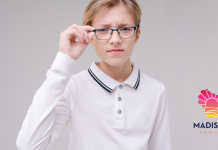By Dr. Kellye Knueppel
This post is sponsored by The Vision Therapy Center, which has offices in Brookfield, Fond du Lac, and Madison, Wisc.
 Amblyopia is a condition that affects somewhere around 2 to 4 percent of children. What’s especially concerning about amblyopia — or “lazy eye” as it’s more commonly called — is that it can be difficult to detect.
Amblyopia is a condition that affects somewhere around 2 to 4 percent of children. What’s especially concerning about amblyopia — or “lazy eye” as it’s more commonly called — is that it can be difficult to detect.
That may come as a surprise to parents who assume they could easily identify a child’s eye if it were “lazy”; however, it’s generally not that simple. More importantly, undiagnosed amblyopia can lead to a child struggling with schoolwork, while the condition continues to baffle parents, teachers, and even healthcare professionals.
It’s for reasons like these that I want to share some basic tips for identifying the possible symptoms of amblyopia. But before I do, let me briefly explain what amblyopia is.
Understanding amblyopia, or lazy eye
Generally speaking, amblyopia occurs when one eye sees more clearly than the other, even with the help of corrective lenses. Note that the amblyopic eye itself is likely healthy and physically capable of normal vision.
The problem is actually with the visual system — the eyes, the brain, the visual pathways — and how its components work together.
More specifically, with amblyopia the brain is preventing the amblyopic eye from functioning properly, and that affects binocular, or two-eyed, vision.
Amblyopia and binocular vision
With normal binocular vision, the eyes send two slightly different images to the brain. The brain then combines those images into a single three-dimensional image. (In less frequent cases, amblyopia can affect both eyes.)
Amblyopia can emerge when binocular vision doesn’t function correctly. Possible causes include strabismus, or “crossed eyes,” a condition in which an eye may be visibly turned in, out, up, or down, and anisometropia, which is when there’s a large difference in eyewear prescription between the two eyes.
Poor binocular vision can lead to double vision, which in turn will cause the brain to suppress the signal from one of the eyes. When the suppression occurs consistently over a long enough period of time, the affected eye’s vision will become poor and is now considered the amblyopic (or “lazy”) eye.
Why you won’t likely notice the “lazy” eye
What does a lazy eye look like to someone else? Does it appear physically different in some way? The short answer is no.
Unlike the aforementioned strabismus, or crossed eyes, amblyopia can’t be diagnosed by an eye’s appearance. While a person can have amblyopia as a result of strabismus, not all cases of amblyopia involve strabismus.
That’s why simple observation alone is typically not enough to detect amblyopia. In fact, the term “lazy eye” inaccurately suggests that the eye doesn’t move, appears to do what it wants, or is visibly “lazy” in some other way. But that’s usually not the case.
Also, keep this important point in mind: It’s even possible for a child to have both 20/20 vision and amblyopia. In this case, usually one eye sees 20/20, while the vision with the amblyopic eye is much worse. The child may think their vision is fine because they can see clearly with one eye.
Amblyopia symptoms to look for:
Amblyopia often begins in infancy and can be challenging to identify outside of a comprehensive Functional Vision Exam (see more on that in the diagnosis section below).
To complicate matters, children with amblyopia may not even realize their vision is functioning abnormally because they have no frame of reference to judge their vision against. In other words, they assume everyone else’s vision is like theirs.
Even though this vision problem can be difficult to detect, parents can be alert for potential symptoms like the following:
 Trouble with depth perception
Trouble with depth perception
Since amblyopia prevents or greatly impairs binocular depth perception, children with the condition can:
- Have pronounced difficulty catching objects
- Seem clumsy and frequently bump into objects, walls, and other people
- Misjudge the proximity of another person when conversing
Sure, children are clumsy as they’re growing into their bodies, but keep an eye out for clumsiness beyond the norm. And if your child is resistant to playing catch, usually a natural source of fun for kids, then amblyopia could be the culprit.
 Trouble with schoolwork
Trouble with schoolwork
Amblyopia and reading difficulties in particular can go hand in hand. The condition can affect children’s school performance and cause them to:
- Struggle when identifying letters and learning to read
- Read more slowly than normal
- Have delayed focus when looking up at the board
When diagnosis can actually be easy
I’ve suggested how difficult amblyopia can be to detect. But that’s only partially true.
Amblyopia can actually be easily diagnosed with a Functional Vision Exam administered by a developmental optometrist. That’s why it’s so important for children to have this type of exam from the first year of life onward.
Note that a Functional Vision Exam goes beyond a basic school vision screening or a typical optometric vision exam. It includes a comprehensive assessment of visual information processing, binocular function, and other visual skills.
If a child is not seen and tested regularly by an optometrist, it’s possible that they can go for years before anyone detects amblyopia. Remember, children with amblyopia can’t necessarily report their own symptoms. They assume everyone sees the world as they do, even though amblyopia may be causing their two eyes to see quite differently.
A Vision Quiz can be the first step toward identifying the problem
Few vision problems fade with time. If you recognize your child in any of the symptoms described above, it’s by no means a definitive indication of amblyopia. However, it should prompt you to at least take the free online Vision Quiz that The Vision Therapy Center offers.
The Vision Quiz score will give you an indication of whether further testing in the form of a Functional Vision Exam may be in order.
Please keep in mind that if your child does have amblyopia or any other functional vision problem, there’s good news: Optometric vision therapy has proven to be highly effective at solving a wide range of functional vision problems.
Click here to take the Vision Quiz.
About the author: Dr. Kellye Knueppel is an award-winning developmental optometrist specializing in vision-related learning problems, sports vision, and rehabilitative optometry. She is board-certified in vision development as a Fellow of the College of Optometrists in Vision Development. Since opening The Vision Therapy Center in 1995, she has dedicated herself to helping people overcome their visual problems.












